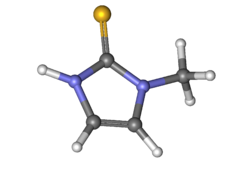Thiamazole
 | |
 | |
| Clinical data | |
|---|---|
| Trade names | Tapazole, others |
| Other names | methimazole (USAN US) |
| AHFS/Drugs.com | Monograph |
| MedlinePlus | a682464 |
| License data |
|
| Routes of administration | By mouth |
| ATC code | |
| Legal status | |
| Legal status | |
| Pharmacokinetic data | |
| Bioavailability | 93% |
| Protein binding | None |
| Metabolism | Liver |
| Elimination half-life | 5-6 hours |
| Excretion | Kidney |
| Identifiers | |
| |
| CAS Number | |
| PubChem CID | |
| IUPHAR/BPS | |
| DrugBank | |
| ChemSpider | |
| UNII | |
| KEGG | |
| ChEBI | |
| ChEMBL | |
| CompTox Dashboard (EPA) | |
| ECHA InfoCard | 100.000.439 |
| Chemical and physical data | |
| Formula | C4H6N2S |
| Molar mass | 114.17 g·mol−1 |
| 3D model (JSmol) | |
| Melting point | 146 °C (295 °F) |
| Solubility in water | 275[1] mg/mL (20 °C) |
| |
| |
| (verify) | |
Thiamazole, also known as methimazole, is a medication used to treat hyperthyroidism.[2] This includes Graves disease, toxic multinodular goiter, and thyrotoxic crisis.[2] It is taken by mouth.[2] Full effects may take a few weeks to occur.[3]
Common side effects include itchiness, hair loss, nausea, muscle pain, swelling, and abdominal pain.[2] Severe side effects may include low blood cell counts, liver failure, and vasculitis.[2] Use is not recommended during the first trimester of pregnancy due to the risk of congenital anomalies, but it may be used in the second trimester or third trimester.[4] It may be used during breastfeeding.[4] Those who developed significant side effects may also have problems with propylthiouracil.[2] Thiamazole is a cyclic thiourea derivative that works by decreasing the production of thyroid hormones.[2]
Thiamazole was approved for medical use in the United States in 1950.[2] It is on the World Health Organization's List of Essential Medicines.[5][6] It is available as a generic medication.[2] It is also available in Europe and Asia.[7] In 2021, it was the 237th most commonly prescribed medication in the United States, with more than 1 million prescriptions.[8][9]
Medical uses[edit]
Thiamazole is a drug used to treat hyperthyroidism such as in Graves' disease, a condition that occurs when the thyroid gland begins to produce an excess of thyroid hormone. The drug may also be taken before thyroid surgery to lower thyroid hormone levels and minimize the effects of thyroid manipulation. Additionally, thiamazole is used in the veterinary setting to treat hyperthyroidism in cats.[10]
Adverse effects[edit]
It is important to monitor any symptoms of fever or sore throat while taking thiamazole; this could indicate the development of agranulocytosis, an uncommon but severe side effect resulting from a drop in the white blood cell count (to be specific, neutropenia, a deficiency of neutrophils). A complete blood count (CBC) with differential is performed to confirm the suspicion, in which case the drug is discontinued.[11] Administration of recombinant human granulocyte colony-stimulating factor (rhG-CSF) may increase recovery.
Other known side effects include:
- skin rash
- itching
- abnormal hair loss
- upset stomach
- vomiting
- loss of taste
- abnormal sensations (tingling, prickling, burning, tightness, and pulling)
- swelling
- joint and muscle pain
- drowsiness
- dizziness
- decreased platelet count (thrombocytopenia)
- aplasia cutis congenita (prenatal exposure)
- thyroid gland enlargement (prenatal exposure)
- choanal atresia (prenatal exposure during the first trimester of pregnancy)
- acute pancreatitis[12][13][14]
Interaction[edit]
Adverse effects may occur for individuals who:
- Take anticoagulants ('blood thinners') such as warfarin (Coumadin), diabetes medications, digoxin (Lanoxin), theophylline (Theobid, Theo-Dur), and vitamins[15]
- Have ever had any blood disease, such as decreased white blood cells (leukopenia), decreased platelets (thrombocytopenia) or aplastic anemia, or liver disease (hepatitis, jaundice)[16]
Mechanism of action[edit]
Thiamazole inhibits the enzyme thyroperoxidase, which normally acts in thyroid hormone synthesis by oxidizing the anion iodide (I−) to iodine (I2), hypoiodous acid (HOI), and enzyme linked hypoiodate (EOI), facilitating iodine's addition to tyrosine residues on the hormone precursor thyroglobulin, a necessary step in the synthesis of triiodothyronine (T3) and thyroxine (T4).[citation needed]
It does not inhibit the action of the sodium-dependent iodide transporter located on follicular cells' basolateral membranes. Inhibition of this step requires competitive inhibitors such as perchlorate and thiocyanate.
A study has shown that it modulates secretion of CXCL10.[17]
Veterinary uses[edit]
Thiamazole is also indicated in cats to treat hyperthyroidism.[18]
Chemical properties[edit]
The cyclic thiourea derivative thiamazole is a white to matte brown crystalline powder with a characteristic odour. The boiling point is 280 °C (decomposition). Thiamazole is soluble in water, ethanol and chloroform, but hardly soluble in ether.[19]
Thiamazole acts as a free radical scavenger for radicals such as the hydroxyl radical (•OH) radical.[20] It is used as free radical scavenger in organic chemistry.[21]
Laboratory synthesis[edit]
Thiamazole has been known since 1889,[22] when it was made by a two-stage process starting from 2,2-diethoxyethaneamine, which was reacted with methyl isothiocyanate.[23]
The product of this reaction was then cyclised in an acid-catalysed reaction to form thiamazole.[23]
Manufacture[edit]
When the therapeutic potential of thiamazole was recognised in the late 1940s, a number of alternative routes were developed based, for example, on the use of 2-chloro-1,2-diethoxyethane as starting material, in a reaction with methylamine.
The resulting intermediate can be treated with potassium thiocyanate in the presence of acid to give thiamazole.[23]
History[edit]
Surgery was used to treat hyperthyroidism until the advent of drug therapies in the 1940s. In 1942, thiourea was used by Edwin B. Astwood to treat a patient with the condition. He later published evidence that thiouracil was more effective and began a search for analogues with higher potency and less toxicity.[10][24] In 1949 he published his work on thiamazole which showed its superiority to previous therapies.[10] The compound had been known since 1889,[22][23] and was developed as a drug by Eli Lilly and Company under the trade name Tapazole.[25]
References[edit]
- ^ "DrugBank: Methimazole (DB00763)". drugbank.ca. Retrieved 21 July 2015.
- ^ a b c d e f g h i "Methimazole Monograph for Professionals". Drugs.com. American Society of Health-System Pharmacists. Retrieved 8 April 2019.
- ^ Spina D (2008). The Flesh and Bones of Medical Pharmacology E-Book. Elsevier Health Sciences. p. 74. ISBN 9780723437161.
- ^ a b "Methimazole Use During Pregnancy". Drugs.com. Retrieved 8 April 2019.
- ^ World Health Organization (2019). World Health Organization model list of essential medicines: 21st list 2019. Geneva: World Health Organization. hdl:10665/325771. WHO/MVP/EMP/IAU/2019.06. License: CC BY-NC-SA 3.0 IGO.
- ^ World Health Organization (2021). World Health Organization model list of essential medicines: 22nd list (2021). Geneva: World Health Organization. hdl:10665/345533. WHO/MHP/HPS/EML/2021.02.
- ^ Yoshihara A, Noh J, Yamaguchi T, Ohye H, Sato S, Sekiya K, et al. (July 2012). "Treatment of graves' disease with antithyroid drugs in the first trimester of pregnancy and the prevalence of congenital malformation". The Journal of Clinical Endocrinology and Metabolism. 97 (7): 2396–2403. doi:10.1186/1756-6614-8-S1-A12. PMC 4480840. PMID 22547422.
- ^ "The Top 300 of 2021". ClinCalc. Archived from the original on 15 January 2024. Retrieved 14 January 2024.
- ^ "Methimazole - Drug Usage Statistics". ClinCalc. Retrieved 14 January 2024.
- ^ a b c Burch, Henry B.; Cooper, David S. (2018). "Antithyroid drug therapy: 70 years later". European Journal of Endocrinology. 179 (5): R261–R274. doi:10.1530/EJE-18-0678. PMID 30320502.
- ^ Fumarola A, Di Fiore A, Dainelli M, Grani G, Calvanese A (November 2010). "Medical treatment of hyperthyroidism: state of the art". Experimental and Clinical Endocrinology & Diabetes. 118 (10): 678–684. doi:10.1055/s-0030-1253420. PMID 20496313.
- ^ Pecere A, Caputo M, Sarro A, Ucciero A, Zibetti A, Aimaretti G, et al. (December 2020). "Methimazole Treatment and Risk of Acute Pancreatitis: A Population-based Cohort Study". The Journal of Clinical Endocrinology and Metabolism. 105 (12): e4527–e4530. doi:10.1210/clinem/dgaa544. PMID 32813014. S2CID 221181752.
- ^ Brix TH, Lund LC, Henriksen DP, Folkestad L, Bonnema SJ, Hallas J, Hegedüs L (March 2020). "Methimazole and risk of acute pancreatitis". The Lancet. Diabetes & Endocrinology. 8 (3): 187–189. doi:10.1016/s2213-8587(20)30025-5. PMID 32035032.
- ^ Pharmacovigilance Risk Assessment Committee (PRAC) (4 January 2019). "PRAC recommendations on signals" (PDF). European Medicines Agency. EMA/PRAC/826440/2018.
- ^ Busenbark, Laura A.; Cushnie, Sally A. (May–June 2006). "Effect of Graves' disease and methimazole on warfarin anticoagulation". The Annals of Pharmacotherapy. 40 (6). doi:10.1345/aph.1G422. ISSN 1060-0280. PMID 16735660 – via Sage Journals.
- ^ "Methimazole (Oral Route) Precautions - Mayo Clinic". www.mayoclinic.org. Retrieved 31 March 2024.
- ^ Crescioli C, Cosmi L, Borgogni E, Santarlasci V, Gelmini S, Sottili M, et al. (October 2007). "Methimazole inhibits CXC chemokine ligand 10 secretion in human thyrocytes". The Journal of Endocrinology. 195 (1): 145–155. doi:10.1677/JOE-07-0240. PMID 17911406.
- ^ "Managing hyperthyroidism in cats." by S Caney, Veterinary Times 2012 Vol.42 No.46 pp.12-15
- ^ Entry on Thiamazol. at: Römpp Online. Georg Thieme Verlag, retrieved 10. November 2014.
- ^ Taylor JJ, Willson RL, Kendall-Taylor P (29 October 1984). "Evidence for direct interactions between methimazole and free radicals". FEBS Letters. 176 (2): 337–340. doi:10.1016/0014-5793(84)81192-8. S2CID 86322153.
- ^ Inhibition of amine oxide, 30 December 2010, retrieved 14 April 2019
- ^ a b Wohl, A.; Marckwald, W. (1889). "Ueber Condensations-producte aus Amidoacetal. (II.)". Berichte der Deutschen Chemischen Gesellschaft (in German). 22: 1353–1362. doi:10.1002/cber.188902201280.
- ^ a b c d Baranov, V. V.; Galochkin, A. A.; Kravchenko, A. N. (2023). "A novel approach to the synthesis of methimazole". Russian Chemical Bulletin. 72 (8): 1946–1949. doi:10.1007/s11172-023-3983-y.
- ^ Astwood, E. B. (1984). "Landmark article May 8, 1943: Treatment of hyperthyroidism with thiourea and thiouracil. By E.B. Astwood". JAMA: The Journal of the American Medical Association. 251 (13): 1743–1746. doi:10.1001/jama.251.13.1743. PMID 6422063.
- ^ Davidson, L. A. G. (1953). "Methimazole in Treatment of Thyrotoxicosis". BMJ. 2 (4849): 1300–1303. doi:10.1136/bmj.2.4849.1300. PMC 2030295. PMID 13106417.


